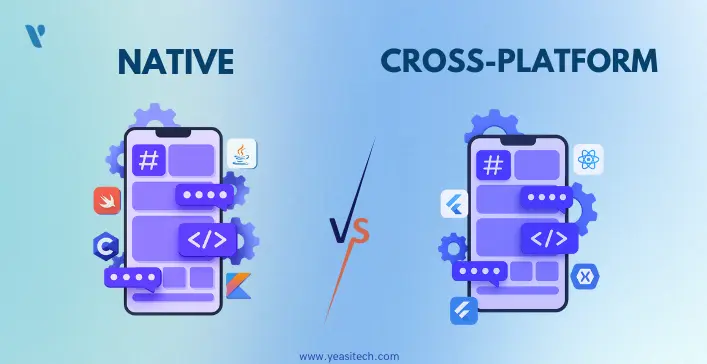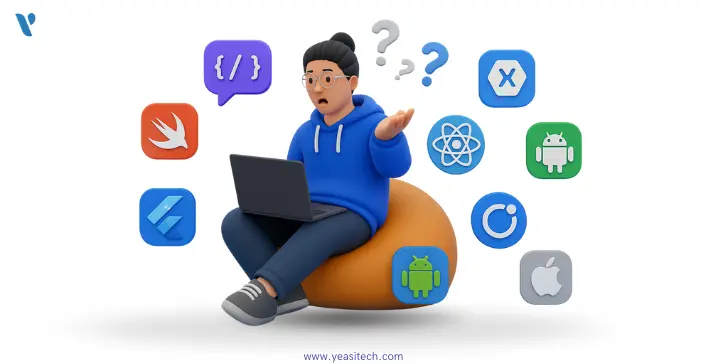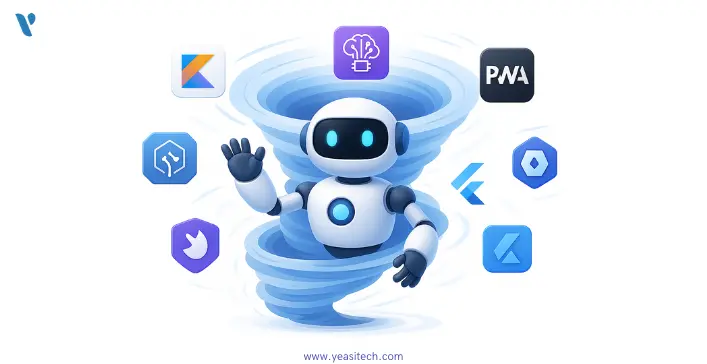Best Technology to Develop Mobile Applications: The Ultimate 2025 Guide

If you’re a business owner, startup founder, or someone with a brilliant idea, there’s one big question you must face: What is the best technology to develop mobile applications?
Think about the last time you ordered food, booked a ride, or even meditated — chances are, you did it using a mobile app. Today, mobile applications are not just a trend but a way of life. With over 257 billion app downloads globally in 2023 (Statista), it’s clear that mobile apps power the digital economy.
In this blog, we’ll go through everything you need to know to choose the best technology for mobile app development in 2025. Whether you’re a small business owner, startup founder, or someone just curious about the tech behind the apps, this guide is written with simplicity, clarity, and practicality in mind.

When it comes to mobile app development, you’ve got two main roads:
Native apps are built specifically for one operating system — either iOS (Apple) or Android (Google). They are like tailor-made suits: designed to perfectly fit one platform.
| PROS | CONS |
| Super fast performance | You need to build and maintain two separate apps for iOS and Android |
| Access to all device features (camera, GPS, Bluetooth, etc.) | Can be more expensive and time-consuming |
| Better UI/UX tailored to platform guidelines | Duplicated Effort – Features must be implemented twice |
Writing a single codebase that runs on both iOS and Android is known as cross-platform. It’s similar to writing a single letter that both Google and Apple, friends, can understand. Popular cross-platform frameworks include:
| PROS | CONS |
| Faster development time | Slightly lower performance compared to native |
| Cost-effective | Not all device features are available |
| Easier to maintain | UI might not feel “native” to some users |
As of 2025, Statista reports Flutter as the preferred cross‑platform framework at 42%, with React Native close behind at 38%

If you want top-tier quality and performance in mobile applications, these are the go-to native technologies:
Kotlin has officially replaced Java as the preferred language for Android. It’s modern, safer, and far more readable.
Why Kotlin?
Swift is Apple’s powerful and intuitive programming language. It’s designed for performance and safety.
Why Swift?
Swift is the future of Apple development.” – Tim Cook, CEO of Apple
Cross-platform is perfect for startups, MVPs, and mobile applications that don’t need extreme hardware control
Flutter is a powerful UI toolkit that uses the Dart language. It lets you build natively compiled apps for mobile, web, and desktop — from a single codebase.
Pros:
“Flutter isn’t just a framework; it’s an ecosystem.” – Tim Sneath, Product Manager at Google
Stat to Know: In a 2024 developer survey by Statista, 42% of developers chose Flutter as their preferred cross-platform framework.
React Native uses JavaScript and React to build mobile applications. It’s known for its fast development cycle and huge community.
Pros:
Mobile app development is constantly evolving. Here are some cutting-edge technologies shaping the future:
Low-code is no longer just a trend. It’s a movement.” – Forrester Research
PWAs blend web and app experiences. They’re fast, work offline, and are perfect for businesses that want a web-first presence.
Languages like Rust (for performance) and Dart (used in Flutter) are becoming developer favorites for scalable, modern apps.
Great mobile applications don’t just look good—they run smoothly thanks to a powerful backend. Here’s what’s under the hood:
Tip: Don’t forget to budget for backend maintenance and cloud costs — especially as your user base grows.
Still unsure which tech is best for your mobile applications? Here are the main questions you need to answer:
| Questions | What to Consider |
| What’s your budget? | Native = Higher cost Cross-platform = Budget-friendly |
| What’s your timeline? | Short time = Cross-platform or low-code Long-term product = Native or hybrid |
| How complex is your app? | Simple apps (MVP, directory, store): Cross-platform Complex apps (games, AR/VR, sensors): Native |
| Do you have an in-house team or outsourcing? | Hard to hire Swift/Kotlin devs? Go with React Native or Flutter |
| User Experience priorities? | Native always wins in performance and UX |
| Scalability needs? | Plan backend tech early for growth |
At YeasiTech, we work with startups and businesses to choose the best mobile app development technology based on your goals, your users, and your budget, not just trends.
We also help you scale from MVP to full product and integrate the right analytics, payment gateways, third-party APIs, and more.
“We don’t just write code — we build experiences that users love.” – Team YeasiTech
Choosing the best technology for your mobile app isn’t just a technical decision — it’s a business decision. Whether you go native, cross-platform, or explore low-code tools, your choice should align with your goals, users, and growth plans.
Remember:
The good news? You don’t have to figure it out alone.
At YeasiTech, we help founders, startups, and businesses make the right tech decisions and turn their ideas into stunning, scalable apps. From strategy to development and post-launch support — we’ve got your back.
Ready to start? Let’s chat about your app idea — no tech jargon, just real results.

The best technology depends on your goals. For performance, go with native tools like Swift (iOS) and Kotlin (Android). For speed and flexibility, Flutter is a top cross-platform choice in 2025.
Native development builds separate apps for iOS and Android using platform-specific languages, while cross-platform uses a single codebase to run on both.
Yes, in 2025, Flutter often leads with better performance, UI consistency, and developer support. However, React Native still has a strong ecosystem.
Popular backend choices include Node.js, Firebase, Django, and Laravel, depending on your app’s complexity, scalability, and real-time needs.
Consider app type, performance needs, development budget, time-to-market, scalability, and developer availability when selecting your tech stack.
It’s possible but costly. Migrating tech stacks post-launch requires major redevelopment, so it’s best to choose the right technology from the start.
YeasiTech is a trusted IT service partner with 8+ years of experience, empowering 250+ businesses with scalable web, mobile and AI solutions.
Explore related topics to broaden your understanding and gain actionable insights that can transform your strategies.